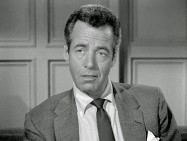
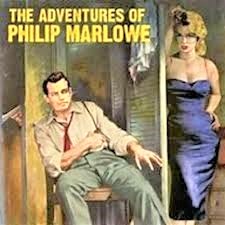 The Adventures of Philip Marlowe (1948-51) aired “The Old Acquaintance” on December 26, 1948 as the 14th of its 114 episodes. This is but the second episode of the show we have showcased here, the first coming in May of this year. For those coming to the show for the first time I reprise the introductory material from that initial episode.
The Adventures of Philip Marlowe (1948-51) aired “The Old Acquaintance” on December 26, 1948 as the 14th of its 114 episodes. This is but the second episode of the show we have showcased here, the first coming in May of this year. For those coming to the show for the first time I reprise the introductory material from that initial episode.
The original brief run starring Van Heflin debuted as a summer replacement for The Bob Hope Show from June 17, 1947 – September 19, 1947. For various reasons it didn’t wow audiences, or the creator of the character himself, Raymond Chandler, and so was cancelled, only to be retooled with a new actor as Marlowe (the incomparable Gerald Mohr, 1914-1968, photo top right) and new scripts (and with New in the title).
Mohr was a ubiquitous figure in radio and later in television. Just a few of his more than 500 radio appearances as star or supporting character include: Jungle Jim, Archie Goodwin on The New Adventures of Nero Wolfe, The Whistler, The Shadow of Fu Manchu, Box 13, Escape, and many others. Beginning in the 1950s, Mohr appeared in more than 100 TV series during his life, among them: Maverick, The Lawman, Cheyenne, Sugarfoot, Bonanza, The Rifleman, and other Westerns. Non-western TV appearances included but were not limited to: Perry Mason, 77 Sunset Strip, Hawaiian Eye, and of SF interest episodes of Lost in Space and Voyage to the Bottom of the Sea. Of interest to comic books fans, Mohr did the voice of Reed Richards in The Fantastic Four animated cartoon series in 1967, and that of Green Lantern in the animated Aquaman series in 1968.
Conversant in Swedish, Mohr had flown to Stockholm in the Fall of 1968 to star in the pilot of a proposed television series. Shortly after filming he dropped dead of a heart attack on November 9th, 1968 at the age of 54. He was buried on the island of Lidingo, Sweden.
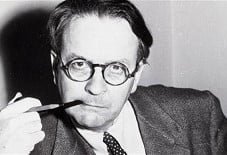 Raymond Chandler (1888-1959, photo at right) wasn’t the first to create what would come to be known as the hard-boiled detective. Dashiell Hammett was first on the scene with his Sam Spade character introduced in his 1930 novel The Maltese Falcon (first serialized beginning in the September 1929 issue of Black Mask magazine). But with Chandler’s first novel, The Big Sleep, published in 1939, he took the gritty, noir detective novel to a new level with his tough as nails private eye, Philip Marlowe. (It should be noted here that the screenplay for the classic 1946 version of the film was co-scripted by William Faulkner, Jules Furthman, and none other than SF’s own Leigh Brackett. It starred Humphrey Bogart as Marlowe and his new real life wife Lauren Bacall as Vivian Rutledge.) Marlowe’s character was not only able to handle himself on the street, he was an intellectual cut above the average gumshoe in that he had attended college, played chess, and had an ear for classical music. This side of his character only masked his off the cuff ability to fling witty descriptions and ready-made similes to pepper his
Raymond Chandler (1888-1959, photo at right) wasn’t the first to create what would come to be known as the hard-boiled detective. Dashiell Hammett was first on the scene with his Sam Spade character introduced in his 1930 novel The Maltese Falcon (first serialized beginning in the September 1929 issue of Black Mask magazine). But with Chandler’s first novel, The Big Sleep, published in 1939, he took the gritty, noir detective novel to a new level with his tough as nails private eye, Philip Marlowe. (It should be noted here that the screenplay for the classic 1946 version of the film was co-scripted by William Faulkner, Jules Furthman, and none other than SF’s own Leigh Brackett. It starred Humphrey Bogart as Marlowe and his new real life wife Lauren Bacall as Vivian Rutledge.) Marlowe’s character was not only able to handle himself on the street, he was an intellectual cut above the average gumshoe in that he had attended college, played chess, and had an ear for classical music. This side of his character only masked his off the cuff ability to fling witty descriptions and ready-made similes to pepper his 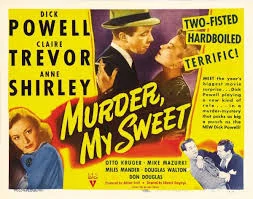 already colorful narratives, and was to become one of his trademarks, emulated by many another writer who wished to show how clever their own detective creations were. It became a widely recognized form of dialogue that later transferred itself well to the silver screen, custom made for audiences eager for the noir crime/detective experience, and was given full voice in the movie adaptation of Chandler’s 1940 novel Farewell, My Lovely. Released in 1944 under the novel’s original title in the UK, for American audiences the title was changed to Murder, My Sweet and starred Dick Powell and Claire Trevor. It was a well-received, seminal film that helped define the noir genre, and was a breakthrough role for Powell as well, who had spent a good decade or more playing the young, handsome, crooning playboy roles but never the serious leading man.
already colorful narratives, and was to become one of his trademarks, emulated by many another writer who wished to show how clever their own detective creations were. It became a widely recognized form of dialogue that later transferred itself well to the silver screen, custom made for audiences eager for the noir crime/detective experience, and was given full voice in the movie adaptation of Chandler’s 1940 novel Farewell, My Lovely. Released in 1944 under the novel’s original title in the UK, for American audiences the title was changed to Murder, My Sweet and starred Dick Powell and Claire Trevor. It was a well-received, seminal film that helped define the noir genre, and was a breakthrough role for Powell as well, who had spent a good decade or more playing the young, handsome, crooning playboy roles but never the serious leading man.
As for “The Old Acquaintance,” it began as many a Philip Marlowe radio adventure did, with a dramatic tease introducing the crucial elements of the episode, and which in this case just about says all you need to know. So without further ado, enjoy “The Old Acquaintance” and the tantalizing introduction to this Philip Marlowe mystery:
“When it started, a girl’s wedding and New Year’s Eve were only six hours away.
And I didn’t think the bride-to-be would make either one of them. But that was before
I ran up against a slot machine operator, the escaped convict and above all,
the old acquaintance.”
Play Time: 29:25
{Many in the neighborhood gang hit the jackpot for Christmas in 1948, finding actual folding money in their Christmas stockings (no doubt from grandparents). A one dollar bill to a youngster in 1948 felt like finding buried treasure, so the gang found themselves at the corner newsstand in record time, looking for some of their favorite magazines to immerse themselves in on New Year’s Eve, when parents would leave them with an older sibling or a baby sitter while they spent the night at parties. Astounding SF (1930-present, now Analog) was a sure buy for the SF fans in the gang, and with a new story (now a minor classic) by Poul Anderson gracing the cover it was a no brainer. Astounding was a monthly in 1948. Dime Mystery (1932-50) began as a straight up detective magazine but after only 10 issues switched its focus to one of “weird menace,” a formula which worked well for close to 18 years. In 1948 it managed 7 issues, one less than in 1947 (8) and one more than in 1949 (6). It continued its downhill publishing slide with only 5 issues in 1950, the year it ceased publication. The Phantom Detective (1933-53), published by Standard Magazines, was a direct response to Street & Smith’s extremely popular The Shadow magazine. It must have done something right to have entertained enough readers to survive for two decades. It was a bi-monthly in 1948.]
[Left: Astounding, Dec. 1948 – Center: Dime Mystery, Nov. 1948 – Right: Phantom Detective, Dec. 1948]
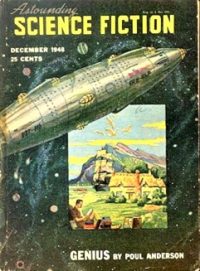
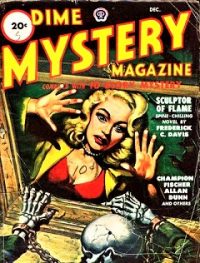
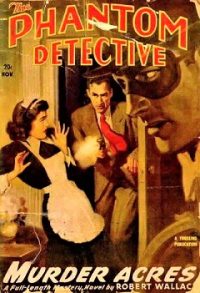
To view the entire list of Old Time Radio episodes go here.